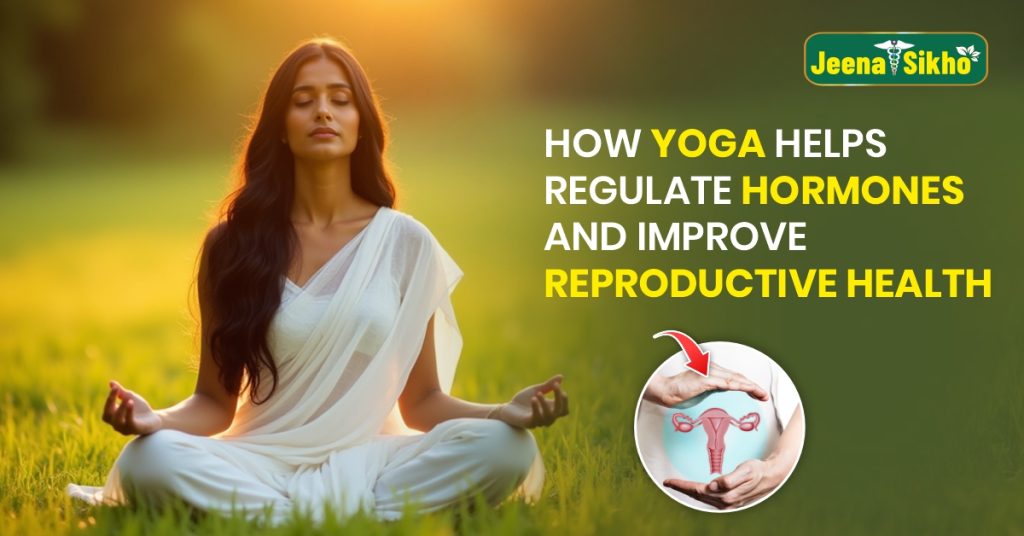Your body is in order, your hormones are in harmony, your energy is in tune, your moods are normal, and reproduction is at its peak when everything is balanced. But, once hormonal imbalance begins, it usually becomes the reason for having irregular periods, acne, fertility issues, or even PCOS. Among all the natural ways to heal, yoga for hormone balance is a relaxing, rejuvenating, and successful method. Yoga benefits the nervous system, hormones, the body’s range of motion, and your mind.
As a drug-free, side-effect-free treatment, yoga for PCOS and fertility is increasing worldwide. Yoga has a significant effect, including increased ovulation, nervous system relaxation, and decreased stress-related hormone levels through its adverse impact on the nervous system. Let’s explore how yoga can help reach the body’s natural balance, regulate its hormones, and solve problems with the reproductive system.
Ayurveda and Yoga: The Holistic Hormone Healers
Yoga for hormone balance is deeply rooted in Ayurvedic principles. Ayurveda looks at hormonal imbalance not as a standalone issue but as a result of dosha imbalance—especially Vata and Kapha. When practiced with Ayurvedic dietary guidance and lifestyle routines, yoga helps stabilize the doshas, improve Agni (digestive fire), and support hormonal glands like the ovaries, thyroid, and pituitary. Poses, breathing, and relaxation all work together to restore internal balance gently and naturally.
The principles of Ayurveda have always been connected with yoga for women’s health treatments. Instead of looking at hormonal imbalance as a separate problem, Ayurveda views it as a cause of dosha imbalance, i.e., Vata and Kapha. Among other things, practised with Ayurvedic eating instructions and lifestyle rhythms, yoga stabilises the doshas, optimises Agni (digestive flame), and nourishes hormonal glands, such as the ovaries. Thyroid and pituitary. Poses, breathing, and relaxation function to restore internal balance with as much subtlety as naturally.
Understanding Hormonal Imbalance and Reproductive Disorders
What Causes Hormonal Imbalance?
Chemical messengers called hormones control mood, sleep, fertility, and ovulation. An imbalance can occur due to:
1. Chronic stress
2. Lack of sleep or erratic lifestyle
3. Poor nutrition or excessive junk food
4. Exposure to endocrine-disrupting chemicals (plastics, cosmetics, etc.)
5. Weight fluctuations or a sedentary lifestyle
6. Thyroid or insulin resistance problems
Symptoms You Shouldn’t Ignore
Hormonal imbalance and reproductive disorders usually show up through signs like
1. Irregular or absent periods
2. Severe mood swings or PMS
3. Weight gain, especially around the belly
4. Acne, unwanted hair, or hair fall
5. Infertility or trouble conceiving.
6. Low libido or fatigue
One of the most common conditions linked to hormonal imbalance is PCOS (Polycystic Ovary Syndrome), which causes irregular periods, insulin resistance, and ovarian cysts. Many women also experience thyroid dysfunction or early menopause symptoms in their 30s. Conditions that can significantly benefit from consistent outcomes.
Watch this video : Ayurvedic Treatment For PCOS & PCOD
Yoga for women’s health: Hormone Balance and Reproductive Wellness
Yoga works on the nervous system, endocrine glands, digestive organs, and reproductive tissues simultaneously. Making it a powerful tool in supporting overall well-being through yoga for women’s health.
i) Yoga Asanas That Stimulate Hormonal Glands
The ovarian, thyroid, adrenal, and pancreatic glands are all stimulated by specific yoga poses:
1. Sarvangasana (Shoulder Stand) – balances thyroid and pituitary
2. Bridge Pose, or Setu Bandhasana, lowers PMS and promotes ovarian function.
3. Bhujangasana, also known as Cobra Pose, stimulates the adrenal glands and relieves fatigue.
4. The Butterfly Pose, also known as Baddha Konasana, promotes fertility by opening the pelvic area.
5. The Seated Forward Fold (Pachimottanasana) enhances digestion and stimulates the mind.
These asanas improve blood flow to reproductive organs, ease menstrual discomfort, and bring hormonal harmony.
ii) Breathing Techniques for Nervous System and Hormones
Hormones are deeply influenced by stress. Practices like
1. Nadi Shodhana (Alternate Nostril Breathing)
2. Bhramari (Bee Breath)
3. Sheetali (Cooling Breath)
These pranayamas calm the hypothalamus and pituitary gland—the two hormonal “control towers” of your body.
iii) Meditation to Reset the Brain-Hormone Connection
Regular meditation resets your brain’s stress response, reduces cortisol (stress hormone), and enhances serotonin and melatonin balance. This supports restful sleep, better moods, and reproductive health.
iv) Yoga Nidra and Deep Relaxation
Yoga Nidra, or guided yogic sleep, is highly effective in restoring hormonal balance. It helps the body shift into the parasympathetic (healing) state, which is especially useful in yoga for PCOS and fertility support.
Lifestyle and Diet Along with Yoga
Yoga for women’s health alone is powerful, but when paired with simple lifestyle and dietary practices, the effect becomes long-lasting:
- Sleep Early and Wake with Sunrise: Circadian alignment improves melatonin and cortisol cycles
- Eat Fresh and Seasonal Foods: Avoid refined sugars, dairy, and processed foods.
- Add Ayurvedic herbs that aid in hormone regulation, such as turmeric, triphala, ashwagandha, and shatavari.
- Avoid Plastic and Hormone-Disrupting Chemicals in skincare, food packaging, etc.
- Follow a consistent yoga routine: even 20–30 minutes daily makes a difference.
Avoid pushing yourself into extreme workouts or restrictive diets; yoga teaches balance over punishment.
Conclusion
With consistent practice, yoga for hormone balance becomes more than just exercise, it becomes a path to self-healing. From regulating periods to improving fertility and emotional well-being, yoga gently rewires the body and mind into alignment. Whether you’re facing PCOS, thyroid issues, or just feel off-balance, yoga gives you a sustainable and empowering tool to feel better naturally.
Take the first step today. Roll out your mat, breathe deep, and begin your healing journey through yoga.
FAQs
Q1. What yoga poses are best for hormonal balance?
Shoulder Stand, Cobra Pose, and Reclined Butterfly help regulate glands and boost hormone production.
Q2. How does yoga help with PCOS and fertility-related problems?
Yoga reduces insulin resistance, balances androgens, and improves ovulation naturally.
Q3. Can yoga improve the chances of conceiving?
Yoga has increased fertility, reduced stress, and improved blood flow to the reproductive system.
Q4. What is the recommended frequency of yoga for hormone balance?
Practicing 4–5 times a week, even for 30 minutes, can create noticeable hormonal changes.
Q5. Is yoga helpful for menopause-related hormonal imbalance?
Specific yoga postures support women’s health by managing hot flashes, mood swings, and sleep disruptions.







